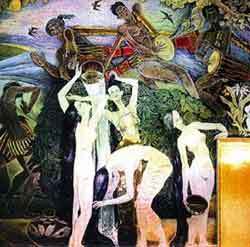By Yan Pei
During the past 30 years in China, there have been two major public debates on sex. The first debate happened in the June of 1979 after a photo showing a couple kissing was published on the back cover of a movie magazine; the second was sparked by a 2008 university course advocating sexual abstinence until marriage.
A kissing film still
|

|
|
A kissing still from the English movie "The Slipper and the Rose".
|
On the morning of June 18, 1979, Lin Shan, then editor-in-chief of Popular Cinema received a strongly worded letter from a reader.
"I am very angry about the photo you published on the back cover of your volume 5, 1979 magazine. I can't believe that anything like this could happen in our socialist country founded by Chairman Mao, especially after we have just been through the Cultural Revolution! It's a disgrace that your magazine has become no different from bourgeois magazines. I have to ask: What do you think you are doing???"
The letter was signed by Xiang Wenying from the Xinjiang Production and Construction Corps. He was so angry that he added three question marks at the end of the letter. The reason for his anger was that the magazine's back cover had a still from the British movie "The Slipper and the Rose" showing a couple kissing.
Tang Jiaren, the deputy editor-in-chief, recalls that the film still was the first kissing photo to be published since China's move towards reform and opening up. The editorial board had hesitated before making up their minds to publish it. But they hadn't expected such strong criticism from readers. Lin and Tang took the letter to the China Film Association – their supervisory authority – to ask what they should do. They decided to publish the full text of the letter in the next issue of the magazine and invite readers to comment.
In less than two months, the magazine had received over 11,200 letters, of which more than one third opposed publication of the picture. The nationwide debate on kissing, the first of its kind in China since the 1978 reform, was later cited by contemporary sex experts as the first step towards "sexual liberalization".
Pan Suiming, a famous sociologist and sexologist from Renmin University of China, defined pre-1978 China as a "sexless society". With reform and opening up, a "sexual revolution" quickly ended the sexless phase of China. "In those days, any sex-related subject would attract the attention of the whole society," said Pan, "the kissing photograph was just the start."
Nude art
In the winter of the same year, a giant mural of a nude female once again aroused Chinese people's curiosity.
|

|
|
"Water-Splashing Festival: A Paean of Life" by Yuan Yunsheng.
|
On October 1, 1979, the newly-completed Capital Airport went into operation and attracted over 300,000 visitors in the following two months. One of the attractions was a giant mural named "Water-Splashing Festival: A Paean of Life". Its painter Yuan Yunsheng, an artist from the China Central Academy of Fine Arts, had taken the plunge and included three nude long haired women in the mural.
Yuan recalls what was a bold action in that period. "I was painting a bathing scene, so naturally people would not have any clothes on. In order to pass the official inspection, I painted extra lines in my sketch to make the women look like they were wearing clothes. I then erased those extra lines before finishing the painting. By the time the authorities found out, it was too late for them to do anything."
In the end, the painting was approved and shown to public. News traveled fast and many Beijing citizens rushed over to take a look at the nude mural. Under pressure from public opinion, three months later the airport covered the nude figures with a piece of gauze. But spectators could still lift the gauze to get a better look.
According to Pan Suiming, Chinese people seemed to have a passion for nudity at that time. Paintings, films and exhibitions that contained female nudity were all the rage. In 1988, a Nude Art Painting Exhibition held in Beijing pushed the people's passion for nudity over the top.
On December 22, 1988, Nude Art Painting Exhibition was held at National Art Museum of China. The exhibition displayed 136 paintings by 28 painters from the China Central Academy of Fine Arts, most of which were oil paintings of nude females.
Ge Pengren, then a young teacher at the Academy, was the general planner of the exhibition. He recalls that there was a long queue outside the ticket office everyday as people lined up to buy tickets. On the last day of the show, thousands of spectators clustered around the artists to have them sign their newly-purchased "Collection of Nude Oil Paintings" books and postcards.
The 18-day exhibition attracted 220,000 spectators. It seemed that China – a country that had just come out of its sexless phase – needed nudity far more than art.
Sex-related publication
Once sexual repression was lifted, people's thirst for sexual knowledge and culture led to a demand for sex-related books and magazines. But the government soon launched a campaign against obscene publications.
In May 1982, a foreign novel titled The Rose Tattoo disappeared overnight from bookstores across the country because it contained "large amounts of obscene depictions." The Rose Tattoo was the first book to be banned in the campaign. Its publisher, the Yanbian People's Publishing House was also fined 600,000 yuan.
In the years up to 1988, more than 30 categories of books were defined as obscene publications, six publishing houses were ordered to suspend operations for rectification, and the over 130 periodicals had issues blocked because of obscene material. The famous book – Lady Chatterley's Lover – was also banned during this period.
In October 1986, chief editor of the Hunan People's Publishing House Zhu Zheng visited an old friend at the State Bureau of Publication on a business trip. During the chat, he said that his company was planning to publish Lady Chatterley's Lover, but his friend advised him not to, because Lijiang Publishing House had already failed to get approval for the book.
After returning to Hunan, Zhu wanted to call off the publication of Lady Chatterley's Lover. But the whole publishing house opposed his decision because they had already received 300,000 advance orders for the book. Buoyed by the prospect of making money, Zhu decided to follow the example of the People's Literature Publishing House, who had just published an abridged version of The Plum in the Golden Vase, a seventeenth century Chinese novel considered to be both pornographic and great literature.
In mid-January 1987, Hunan People's Publishing House formally published Lady Chatterley's Lover. It was a great hit. The trucks of book sellers from all over the country parked outside the printing factory to wait for the books. But in less than a month, the book was banned. The director and deputy director of Hunan Bureau of Publication, and Zhu himself, were severely punished for infringing publication rules.
The same thing happened to renowned novelist Jia Pingwa's 1993 new book Fei Du (The Abandoned Capital), banned a month after its publication.
In January 2004, Lady Chatterley's Lover was published again by the People's Literature Publishing House. The first edition was printed in 50,000 copies and was still popular. Yet society now accepted it calmly.